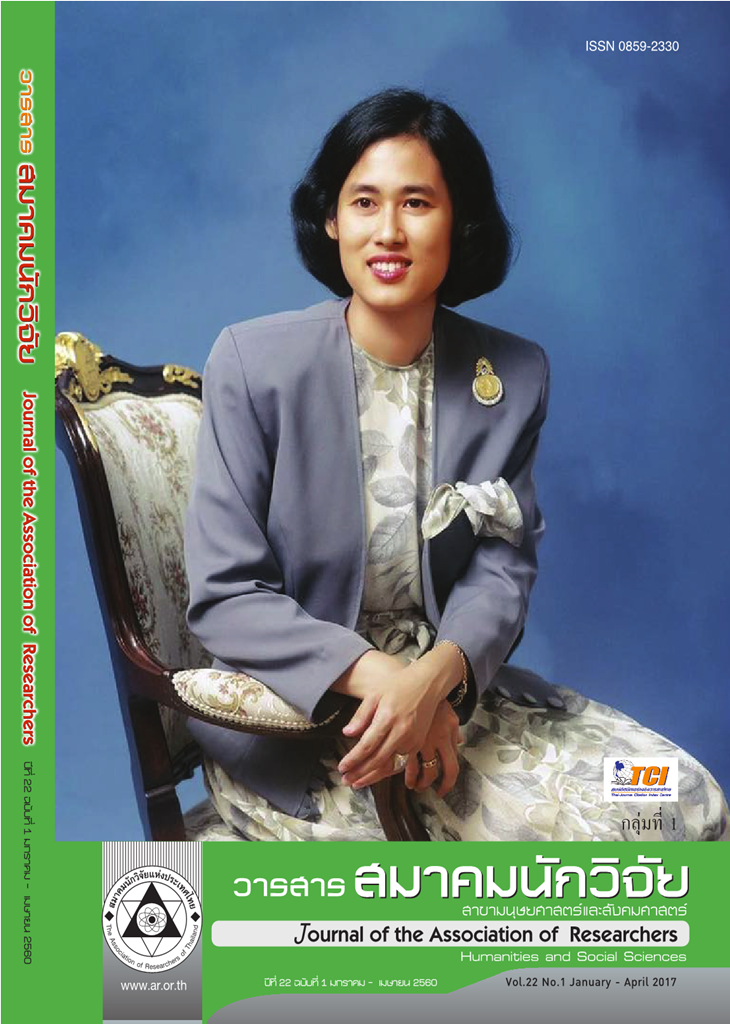The Influence of Attitudes Toward Usability and Related Factors on the Intention Behaviors of Thai Wholesale and Retail Industry Employees in Using Technology
Main Article Content
Abstract
In this thesis, the researcher examines the influence of (1) the perceived ease of use on perceived usefulness, attitudes toward usability, and intention behaviors; (2) the effects of perceived usefulness on attitudes toward use and intention behaviors; and (3) attitudes toward usability and intention behaviors. The sample population consisted of 450 employees working in the wholesale and retail industries. Bangkok Metropolis was the area in which data were collected. The research instrument was a questionnaire. Using techniques of descriptive statistics, the data collected were analyzed in terms of mean and standard deviation. In addition, Pearson’s product moment correlation coefficient method and the structural equation modeling (SEM) technique were also employed by the researcher. Data were analyzed using a computer software program. Findings are as follows: The causal model for the influence of attitudes on usability and related factors on intention behaviors in the use of technology on the part of the personnel under study was found to be congruent with empirical data at a very good level. In carrying out hypothesis testing, the researcher found that all items were congruent with the set hypotheses postulated for this inquiry at the statistically significant level of .01. Research findings showed that the latent variable of perceived ease of use showed positive direct influence on perceived usefulness, positive direct and indirect influence on the attitudes of usability, and positive indirect influence on intention behaviors. The variable of perceived usefulness exhibited positive direct influence on attitudes toward the use and positive indirect influence on intention behaviors. The variable of attitudes toward usability evinced positive direct influence on intention behaviors. This means that perceived ease of use and perceived usefulness exert positive effects on the attitudes and intention behaviors involving the use of technology by the personnel under investigation.
Article Details
บทความที่ปรากฏในวารสารนี้ เป็นความรับผิดชอบของผู้เขียน ซึ่งสมาคมนักวิจัยไม่จำเป็นต้องเห็นด้วยเสมอไป การนำเสนอผลงานวิจัยและบทความในวารสารนี้ไปเผยแพร่สามารถกระทำได้ โดยระบุแหล่งอ้างอิงจาก "วารสารสมาคมนักวิจัย"
References
จักรพงษ์ สื่อประเสริฐสิทธิ์. (2554). ปัจจัยที่มีอิทธิพลต่อการยอมรับเทคโนโลยี : กรณีศึกษาการใช้บริการการสื่อสาร ระหว่างกันผ่านข้อความและรูปภาพแบบทันที ผ่านโทรศัพท์เคลื่อนที่ในเขตกรุงเทพมหานคร. วิทยานิพนธ์ วิทยา ศาสตรมหาบัณฑิต สาขาวิชาการบริหารเทคโนโลยี วิทยาลัยนวัตกรรม มหาวิทยาลัยธรรมศาสตร์.
จุรีพร ทองทะวัย. (2555). ปัจจัยด้านคุณภาพการให้บริการที่มีอิทธิพลต่อการยอมรับของผู้ว่าจ้างในวิสาหกิจขนาดกลางและขยาดย่อม (SMEs) กรณีผู้ให้บริการด้านการพัฒนาระบบงาน. วิทยานิพนธ์ปริญญามหาบัณฑิต คณะสถิติประยุกต์ สถาบันบัณฑิตพัฒนบริหารศาสตร์.
ชลธิชา ศรีแสง. (2555). การยอมรับการใช้งานของระบบการชำระเงินทางอิเล็กทรอนิกส์ กรณีศึกษาธนาคารกรุงศรีอยุธยา จำกัด (มหาชน). วารสารวิจัยมหาวิทยาลัยเทคโนโลยีราชมงคลศรีวิชัย ปีที่ 4. ฉบับที่ 1. หน้า 35-51.
ณัฐสพันธ์ เผ่าพันธ์. (2551). ปัจจัยที่สร้างแรงจูงใจต่อผู้บริโภคในการตัดสินใจซื้อสินค้าผ่านทางเว็บไซค์. รายงานวิจัย ประจำปีงบประมาณปี 2549, มหาวิทยาลัยศรีปทุม.
บุษรา ประกอบธรรม. (2554). การศึกษาการยอมรับเครือข่ายสังคมออนไลน์ของนักศึกษา: กรณีศึกษา มหาวิทยาลัย กรุงเทพ. วารสารสุทธิปริทัศน์, 27(81), 93-108.
พรรณาภรณ์ แสงดี. (2554). ปัจจัยที่มีผลต่อการยอมรับเทคโนโลยีโปรแกรมสำเร็จรูป SCM (Supply Chain Management). การค้นคว้าอิสระวิทยาศาสตรมหาบัณฑิต, มหาวิทยาลัยธรรมศาสตร์.
ศนิ อนันต์รัตนโชติ. (2553). ปัจจัยที่ส่งผลต่อการยอมรับเทคโนโลยีการชำระเงินผ่านระบบเว็บไซต์ (Web Payment) ของผู้ซื้อสินค้าและบริการออนไลน์. การค้นคว้าอิสระปริญญาโท. สาขาวิชาการบริหารเทคโนโลยี, วิทยาลัยนวัตกรรม มหาวิทยาลัยธรรมศาสตร์.
ศศิพร เหมือนศรีชัย. (2554). ปัจจัยที่มีผลต่อการยอมรับ ERP Software ของผู้ใช้งานด้านบัญชี. วิทยานิพนธ์บัญชี มหาบัณฑิต พาณิชยศาตร์และการบัญชีมหาวิทยาลัยธรรมศาสตร์
Reference
Bootsara Prakobtham. (2012). Investigating the acceptance of social networking in students: Case Study of Bangkok University. Suthiparithat Journal, 27(81), 93-108. (In Thai).
Chen, L. (2008). A Model of Consumer Acceptance of Mobile Payment. Int. J. Mobile Communications, 6(1), 32 - 52. Chonticha Srisang. (2012). Adulation for the use of the E-Payment System A Case Study of Ayudhya Bank Public Company Linited. RMUTSV Research Journal, 4(1), 35-51. (In Thai).
Davis, F. D. (1989). Perceived usefulness, perceived ease of use, and user acceptance of information technology. MIS Quarterly, 13(3), 318-339.
Fishbein, M., & Ajzen, I. (1975). Belief, attitude, intention, and behavior: An introduction to theory and research. Reading, MA: Addison-Wesley
Information and Communication Technology, National Statistical Office (2014). The 2014 Establishment Survey on the use of In Information and Communication Technology. Retrieved October 9, 2014, from http://service.nso.go.th/nso/nsopublish/themes/files/ict_estRep57.pdf (In Thai).
Jakkaphong Sueprasertsith. (2011). Factors influencing in acceptance technology A case study of Using Mobile Instant Messaging service in Bangkok. Master of Science, Technology Management, College of Innovation, Thammasat University. (In Thai).
Jureeporn Thongthawai. (2012). Service Quality Factors that Influence the Acceptance of Outsourcing Services in Small and Medium-sized Enterprises (SMEs): A Case of Application Development Outsourcing. Master Degree, Graduate School of Applied Statistics, National Institute of Development Administration. (In Thai).
Lai, V. S., & Li, H. (2005). Technology acceptance model for internet banking : an invariance analysis. Information & Management, 42, 373-386.
Luarn, P.,and Lin, H.H. (2005). Toward an understanding of the behavioral intention to use Mobile Banking. Computers in Human Behavior, 21, 873-891.
Natsapun Paopun. (2008). Factors Motivating Consumers in Purchasing Decision by Using Website. Research Report for Fiscal Year 2006, Sripatum University. (In Thai).
Mckechnie, S., Winklhofer, H., & Ennew, C. (2006). Applying the technology acceptance model to the online retailing of financial services. International Journal of Retail & Distribution Management, 34(4), 388-410.
Pannaporn Saengdee. (2011). The Study on the Acceptance of SCM Software (Supply Chain Management). Master of Science, Technology Management, College of Innovation, Thammasat University. (In Thai).
Sani Ananrattanachot. (2010). The Study on the Acceptance of Web Payment Technology. Master of Science, Technology Management, College of Innovation, Thammasat University. (In Thai).
Sasiporn Muansrichai. (2011). Factors Affecting the Acceptance of ERP Software from the Perspective of Accounting Users. Master of Accounting, Department of Accountancy, Faculty of Commerce and Accountancy, Thammasat University. (In Thai).
Shroff, R. H., Deneen, C. D. & Ng, E. M. W. (2011). Analysis of the technology acceptance model in examining students’ behavioural intention to use aneportfolio system. Australasian Journal of Educational Technology, 27(4), 600-618. cited 9, October 2014.
Wang, Y. –S., Lin, H. –H., and Larn P. (2006). Predicting consumer intention to use mobile service. Info System, 16,57-179.


